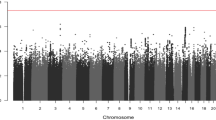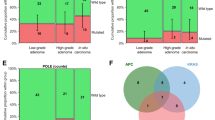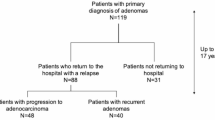Abstract
The colorectal adenoma–carcinoma sequence represents a well-known paradigm for the sequential development of cancer driven by the accumulation of genomic defects. Although the colorectal adenoma–carcinoma sequence is well investigated, studies about tumours of different dignity co-existent in the same patient are seldom. In order to address the distribution of genetic alterations in different lesions of the same patient, we coincidently investigated carcinomas, adenomas and aberrant crypt foci in patients with sporadic colon cancer. By utilizing polymerase chain reaction, single-strand conformation polymorphism, heteroduplex-analysis, restriction fragment length polymorphism, protein truncation test and sequencing techniques we looked for mutations and microsatellite instability of APC, H- ras, K- ras, p53, DCC and the DNA repair genes hMLH1/hMSH2. In accordance with the suggested adenoma–carcinoma sequence of the colon, four patients reflected the progressive accumulation of genetic defects in synchronously appearing tumours during carcinogenesis. However, two patients with non-hereditary malignomas presented different genetic instabilities in different but synchronously appearing tumours suggesting non-clonal growth under almost identical conditions of the environment. Thus, sporadically manifesting multiple lesions of the colon were not necessarily driven by similar genetic mechanisms. Premalignant lesions may transform into malignant tumours starting from different types of genetic instability, which indicates independent and simultaneous tumorigenesis within the same organ. © 2000 Cancer Research Campaign
Similar content being viewed by others
Article PDF
Change history
16 November 2011
This paper was modified 12 months after initial publication to switch to Creative Commons licence terms, as noted at publication
References
Boland CR, Sato J, Saito K, Carethers JM, Marra G, Laghi L and Chauhan DP (1998) Genetic instability and chromosomal aberrations in colorectal cancer: a review of the current models. Cancer Detect Prev 22: 377–382
Breukel C, Tops C, van Leeuwen C, van der Klift H, Nakamura Y, Fodde R and Khan PM (1991a) CA repeat polymorphism at the D5S82 locus, proximal to adenomatous polyposis coli. Nucleic Acids Res 19: 5804
Breukel C, Tops C, van Leeuwen C, van der Klift H, Nakamura Y, Fodde R and Khan PM (1991b) AT repeat polymorphism at the D5S122 locus tightly linked to adenomatous polyposis coli. Nucleic Acids Res 19: 6665
Bufill JA (1990) Colorectal cancer: evidence for distinct genetic categories based on proximal or distal tumor location. Ann Intern Med 113: 779–788
Cawkwell L, Lewis FA and Quirke P (1994) Frequency of allele loss of DCC, p53, RB1, WT1, NF1, NM23 and APC/MCC in colorectal cancer by fluorescent multiplex polymerase chain reaction. Br J Cancer 70: 813–818
Coffey DS (1998) Self-organization, complexity and chaos: the new biology for medicine. Nat Med 4: 882–885
Cross SS, Bury JP, Silcocks PB, Stephenson TJ and Cotton DW (1994) Fractal geometric analysis of colorectal polyps. J Pathol 172: 317–323
Fearon ER and Vogelstein B (1990) A genetic model for colorectal tumourigenesis. Cell 61: 759–767
Ferreira SC, Martins ML and Vilela MJ (1998) A growth model for primary cancer. Physica A 261: 569–580
Friedl W, Mandl M and Sengteller M (1993) Single-step screening method for the most common mutations in familial adenomatous polyposis. Hum Mol Gen 2: 1481–1482
Gregorio CDI, Losi I, Fante R, Modica S, Ghidoni M, Pedroni M, Tamassia MG, Gafà L, Ponz de Leon M and Roncucci L (1997) Histology of aberrant crypt foci in the human colon. Histopathology 30: 328–334
Iniesta P, deJuan C, Caldés T, Vega F-J, Massa M-J, Cerdán F-J, López J-A, Fernándex C, Sánchez A, Torres A-J, Balibrea J-L and Benito M (1998) Genetic abnormalities and microsatellite instability in colorectal cancer. Cancer Detect Prev 22: 383–395
Jiang W, Kahn SM, Guillem JG, Lu S-H and Weinstein B (1989) Rapid detection of ras oncogenes in human tumours: application to colon, esophageal, and gastric cancer. Oncogene 4: 923–928
Jones MH and Nakamura Y (1992) Detection of loss of heterozygosity at the human TP53 locus using a dinucleotide repeat polymorphism. Genes Chromosomes Cancer 5: 89–90
Konishi M, Kikuchi-Yanoshita R, Tanaka K, Muraoka M, Onda A, Okumura Y, Kishi N, lwama T, Mori T, Koike M, Ushio K, Chiba M, Nomizu S, Konishi F, Utsunomiya J and Miyaki M (1996) Gastroenterology 111: 307–317
Luce MC, Marra G, Chauhan DP, Laghi L, Carethers JM, Cherian SP, Hawn M, Binnie CG, Kam-Morgan LN, Cayouette MC, Koi M and Boland R (1995) In vitro transcription/translation assay for the screening of hMLH1 and hMSH2 mutations in familial colon cancer. Gastroenterology 109: 1368–1374
Maesawa C, Tamura G, Suzuki Y, Ogasawara S, Sakata K, Kashiwaba M and Satodate R (1995) The sequential accumulation of genetic alterations characteristic of the colorectal adenoma–carcinoma sequence does not occur between gastric adenoma and adenocarcinoma. J Pathol 176: 249–258
Miyake S, Nagai K, Yoshino K, Oto M, Endo M and Yuasa Y (1994) Point mutations and allelic deletion of tumour suppressor gene DCC in human esophageal squamous cell carcinomas and their relation to metastasis. Cancer Res 54: 3001–3010
Posadas EM, Criley SR and Coffey DS (1996) Chaotic oscillations in cultured cells: rat prostate cancer. Cancer Res 56: 3682–3688
Pretlow TP, Barrow BJ, Ashton WS, O'Riordan MA, Pretlow TG, Jurcisek JA and Stellato TA (1991) Aberrant crypts: putative preneoplastic foci in human colonic mucosa. Cancer Res 51: 1564–1567
Schwab ED and Pienta KJ (1996) Cancer as a complex adaptive system. Med Hypotheses 47: 235–241
Sedivy R (1996a) The potential role of apoptosis (programmed cell death) in a chaotic determined carcinogenesis. Med Hypotheses 46: 455–457
Sedivy R (1996b) Fractal tumours: their real and virtual images. Wien Klin Wochenschr 108: 547–51
Sedivy R and Mader RM (1997) Fractals, chaos, and cancer: do they coincide? Cancer Invest 15: 601–607
Spirio L, Joslyn G, Nelson L, Leppert M and White R (1991) A CA repeat 30–70 kb downstream from the gene. Nucleic Acids Res 19: 6348
Thibodeau SN, Bren G and Schaid D (1993) Microsatellite instability in cancer of the proximal colon. Science 260: 816–819
Waliszewski P (1997) Complexity, dynamic cellular network, and tumorigenesis. Pol J Pathol 48: 235–241
Waliszewski P, Molski M and Konarski J (1998) On the holistic approach in cellular and cancer biology: nonlinearity, complexity, and quasi-determinism of the dynamic cellular network. J Surg Oncol 68: 70–78
Weber JL and May PE (1990) Dinucleotide repeat polymorphism at the D18S34 locus. Nucleic Acids Res 18: 2201
Weissenbach J (1992a) H. sapiens (D2S123) DNA segment containing (CA) repeat. GenBank accession# Z16551
Weissenbach J (1992b) H. sapiens (D2S134) DNA segment containing (CA) repeat. GenBank accession# Z16763
Weissenbach J (1992c) H. sapiens (D2S177) DNA segment containing (CA) repeat. GenBank accession# Z17191
Author information
Authors and Affiliations
Rights and permissions
From twelve months after its original publication, this work is licensed under the Creative Commons Attribution-NonCommercial-Share Alike 3.0 Unported License. To view a copy of this license, visit http://creativecommons.org/licenses/by-nc-sa/3.0/
About this article
Cite this article
Sedivy, R., Wolf, B., Kalipciyan, M. et al. Genetic analysis of multiple synchronous lesions of the colon adenoma–carcinoma sequence. Br J Cancer 82, 1276–1282 (2000). https://doi.org/10.1054/bjoc.1999.1091
Received:
Revised:
Accepted:
Published:
Issue date:
DOI: https://doi.org/10.1054/bjoc.1999.1091
Keywords
This article is cited by
-
Bacteria‐derived ferrichrome inhibits tumor progression in sporadic colorectal neoplasms and colitis‐associated cancer
Cancer Cell International (2021)
-
Molecular characterization of colorectal adenomas with and without malignancy reveals distinguishing genome, transcriptome and methylome alterations
Scientific Reports (2018)
-
Genome-wide copy number changes and CD133 expression characterized distinct subset of colon polyps: differentiation between incidental polyps and cancer-associated polyps
International Journal of Colorectal Disease (2015)
-
Four Percent of Patients Undergoing Colorectal Cancer Surgery may have Synchronous Appendiceal Neoplasia
Diseases of the Colon & Rectum (2007)
-
Influence of age on adenomatous polyposis coli and p53 mutation frequency in sporadic colorectal cancer?rarity of co-occurrence of mutations in APC, K-ras, and p53 genes
Virchows Archiv (2004)



